Positive Health Online
Your Country

Core Energy: Locating the Assemblage Point
listed in energy medicine, originally published in issue 16 - December 1996
The ability to change how we 'feel' and how we 'behave' by adjusting or correcting our Energy Body alignment is nothing short of miraculous. The medical, political and economic benefits are enormous. Once we are familiar with our own Assemblage Point location and that of others, the idea that there is more to a human being than flesh and bone becomes an absolute certainty.
The law of energy conservation states that energy can neither be created nor destroyed. It can only be changed in form. When we are alive, we have 'life' energy in our body. When we are dead that energy is gone. Physics says it doesn't cease to be; it can only change form. Therefore there is a part of us, the energy part that exists beyond the flesh body.
Locating and experiencing our Assemblage Point provides us with personal proof that we all have an Energy Body as well as a physical body.
Working with the Energy Body is not a trivial affair, the Assemblage Point in particular, is a very personal matter, directly connected to the 'Life Force' or spirit of the individual.
Assemblage point description
The Assemblage Point is not part of the physical body. It is an integral component of the Energy Body that surrounds the physical body. It is a large indentation of energy lines which pierce the physical body. Fig. 7 is exaggerated for clarity. Its entry position is 'fixed' or 'stationary'.
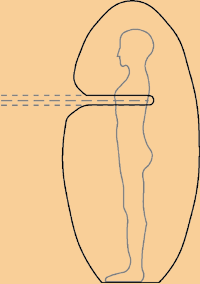
Figure 7 – Energy lines which pierce the body (exaggerated for clarity
The average diameter of the bundle of energy lines is 1 centimetre. It causes a sausage-shaped indentation in the Energy Field. There is an energy 'potential' both along the length of the lines and across their diameter. Where the bundle of lines enters the physical body, they induce a tender or very sensitive area of skin of the same diameter. This tenderness can be quite uncomfortable and can often penetrate through to the shoulder blade.
Where to look
The location of a woman's Assemblage point is generally, but not always, several centimetres higher than a man's. Broadly speaking, a woman's vibrational rate, her behaviour, the way she feels and her view of the world is quite different to that of a man. Therefore, female and male locations tend to be different. These differences also reflect in the efficiency of the chakras in the central core. Women are more efficient on the higher chakras, men doing better on the lower ones. Fig. 8 illustrates commonly found locations for a woman and a man. Finding the precise location and entry angle of the average, healthy, balanced person is a very quick and simple affair.
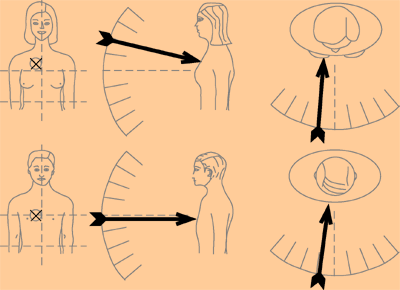
Figure 8 – Women's locations is higher than men's
Subjects with a bright and energetic disposition [high vibrational rate] will have a high location and elevated entry angle. Depressed and lethargic patients such as those suffering from ME or post natal depression will have a low location and descending entry angle. Finding the location and entry angle of patients with mental or physical health problems can be difficult, but gets easier with experience. Often their symptoms, posture, tone of voice will suggest where to look. The 'Off Centre Map', Fig. 9, give a general overview of locations for specific symptoms, there are rare exceptions.
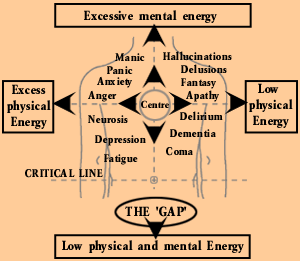
Figure 9 – The "Off Center Map"
Investigators of the Intuitive or Feeling (Jungian) type will not experience any difficulties in locating Assemblage Points. Rational and practical personality types will find difficulties with the feeling and seeing methods listed below. Confidence will develop with experience. Therefore, it is best to work in a small team and compare results. Maintain good records for each subject. Note their medication, symptoms, age, sex, and profession. When shifting Assemblage Points, make a drawing of the location and entry angle for future reference.
The following methods and procedures for locating the Assemblage Point will be quickly confirmed and improved on by other investigators. Photographic and electronic evidence of the Assemblage Point will follow.
Feeling the location
1 The subject should stand upright, looking ahead at the horizon. The investigator should stand facing the subject right-hand body side. Fig. 10.
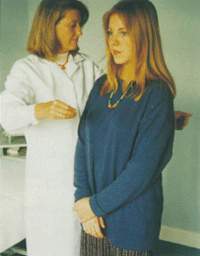
Figure 10
2 Form your left-hand into a cup shape, Fig 11. Use it to 'feel' for the sausage shaped end of the subject's Assemblage Point in the area of the shoulder blades. Fig. 11
3 Form the fingers and thumb of your right-hand into a tight, concentrated point. Fig 11. Use this hand to 'feel' for the bundle of energy lines entering the subject.
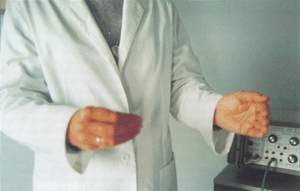
Figure 11
4 Hold both of your arms wide apart. Hold your left-hand behind the subject and your right-hand in front. Standing relaxed, be keenly aware of your physical feelings and your weight on the floor. It helps to close your eyes or look away. Slowly bring your hands towards the subject feeling for the maximum energy. Allow the subject's energy to control your arm muscles.
5 The difference in energy potential along the bundle of lines of the Assemblage Point makes it easy to distinguish. When your cupped hand and pointed fingers are lined up with the subject's bundle of energy lines, you will experience an energy surge. This will pass through your arms and chest. Sensitive subjects will also feel this surge.
6 Bring your hands together feeling for the maximum power and connection with your subject. Allow your hands to touch the subjects back and chest at the points of maximum energy connection.
7 Move your right-hand fingers back and forth across the Assemblage Point. Most subjects will feel a 'pulling' sensation deep inside the chest. Use small, adhesive labels to mark these positions back and front.
Kinesiology
This procedure is not suitable for frail or exhausted patients.
1 Stand facing the subject. With your left arm, use the standard muscle test on the subject's right arm as in Fig 12.
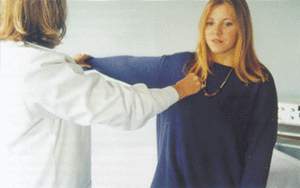
Figure 12
2 Grouping the fingers to a point as before, move your right hand across the subject's chest. Keep the hand at a distance of 5 centimetres away from the chest.
The subject's arm will drop when you move across the location.
3 Check the entry angle by testing the subject's arm muscle strength further away from the chest. Drawing your fingers in an out along the Assemblage Point Lines will reflect in the subjects arm muscle tone.
4 Touching the chest at the entry location will weaken the subject's arm muscles.
Biofeedback
Touching or pushing the Assemblage Point with a finger will stimulate a stress/arousal response in the subject's body. This arousal response will cause the subject's skin resistance to change. This change can be detected by many of the biofeedback devices available to day. Clinicians working with the more expensive, electronic biofeedback systems will probably be able to offer scientific proof of the Assemblage Point's existence and location.
The skin at the point of entry on the chest has different electrical properties from the surrounding skin. These differences are measurable with sensitive electronic instrumentation. However, this is a very sensitive area of the body and prolonged experimentation with testmeters or other equipment could be irritating to the subject.
Seeing the location
This method is the most difficult to describe and comprehend, yet ironically, the simplest and least obtrusive way to locate assemblage points. The method, although totally subjective, is most useful in assessment and diagnosis. If you can 'see' your patient's alignment, it becomes possible, with experience, to describe to your patient his symptoms and experiences before being told about them.
Always look for the Assemblage Point before you use any of the above methods to locate it. Confirming the location by using the other methods will develop your confidence and accuracy in 'seeing' it.
Realise the truth that what we see 'outside' is not the actual object but a hologram or mental construct of it 'inside' our mind. Whilst intensely observing your subject, suspend all thinking and judgements. Perceive the space surrounding your subject as charged with energy.
Try to see the energy as effervescent particles. Look for a concentration of these particles in front of and on the surface of your subject. Where the particles are most concentrated you will find the assemblage point location. These particles may be bright or dull. Look for lines of flux, flowing to a small concentrated bright spot or even a shadow on the subject. Note the location and angle.
Confirming the location
At the location, the skin is less resilient and more painful to the touch. The skin is often blemished or marked in some way, sometimes by a reddish spot. Touching or pushing the spot with your finger, will causes the skin to redden more than skin elsewhere on the chest. The spot is tender, sore or uncomfortable. Pushing it causes the subject a feeling of slight unease. The feeling passes deep into the chest, often right through to the shoulder blade.
Patients' consideration
Patients with low locations will often react physically when their assemblage point is found. For example, they may start to tremble or shake as you move your right hand across their Assemblage Point. Sometimes they complain of a long-standing pain in their back where your left hand is. Therefore, do not practice on patients, learn the methods with your friends and colleagues first. When you are confident you can locate them efficiently, then progress to work with patients.
Shadows and splits
From time to time, in the clinical setting, patients can present a shadow or split Assemblage Point. These are most often associated with patients suffering from schizophrenia and manic depression. In several cases of schizophrenia, two locations of the Assemblage Point have been observed on each patient. One shadow location, high up, near the patient's right collar bone and a second brighter location lower down on the same side. Diagnosed manic depressive patients often have two locations, one strong and active and a second shadow location. The locations are generally lower and not so far to the right side, as with diagnosed schizophrenic patients.
It seems that these patients can, by some means not clear to us, shift their location. This in turn changes their behaviour and the way they feel. In this way the patient oscillates between two locations. Split locations can be reunited and shifted across to a more central and stable location for the patient. From a central position the patient's mental and physical health will stabilise.
Babies and children
The Assemblage Point on babies and young children has no fixed location. It is unstable and can move freely. As a child's personality and internal dialogue develops, its' Assemblage Point location begins to be fixed. Given a stable environment, most children's location will becomes fixed when they are around six years of age, or slightly later. Ideally, adolescents and juveniles should be allowed to develop and fix their own location, without interference other than the normal family and educational procedures.
As with adults, children with serious misalignment of their Assemblage Point do not find it easy to integrate with their peers. Youngsters who have experienced accident, intimidation, drug abuse, illness, or psychological problems are likely to have misalignment problems. In such cases, any educational or therapeutic methods that will stabilise and centralise their Assemblage Point will help their development. Children over 10 years of age, with health problems or symptoms caused by misalignment can gain substantial benefits from the shifting and realignment procedures.
The investigator's experience
Ms Doreen B. London University Lecturer. 'I asked Jon about spiritual matters, especially reincarnation. Handing me two powerful therapeutic magnets, he said "the eye cannot see magnetic waves, but we can experience their effects." Then he instructed me to place one magnet in each hand, to bring my hands slowly together. Suddenly the magnet in my left hand jumped out and across several inches to crash against the second magnet in my right hand. The magnetic power was too strong for me to physically control.
He then said, "enveloping every living person is a strong energy field that is visible only under special circumstances." He emphasised that just as I had experienced the power of the magnets, I could, any time I liked, experience the power of the human energy field.
As a practising Christian, I felt great doubt, but also curiosity and took up his challenge. Following instructions, I brought my hands towards his chest and upper back. As my right hand came within twelve inches of his chest a 'power' took over and I could not control my arms. I felt strong tingling sensations pass up my right arm and across my chest, connecting to my left hand at his back. My hands automatically came into and touched the centre of his chest and back. I admit I was frightened. Something beyond me, a field of energy, took control of my hands and arms.
Over the next two weeks I became very aware of my own Assemblage Point location. I was aware of a curved energy line entering my upper right chest through to my shoulder blade. This energy line seemed connected to a kindred spirit 'out there'. The next time I saw Jon, I asked him if he would confirm my location. He told me the precise location and angle of entry, then came over to me and touched the exact spot. Becoming aware of my own Assemblage Point, has confirmed my belief that we all have a 'spirit energy' outside or above the physical body that dies. My discovery complements my Christian faith.'
Case Studies
Every so often, a beneficial discovery or invention comes along that changes the course of fortune and history. Discovering and proving that every human has an Energy Body and Assemblage Point is a major breakthrough.
Part III – final part of this series Shifting Assemblage Points
Comments:
-
No Article Comments available